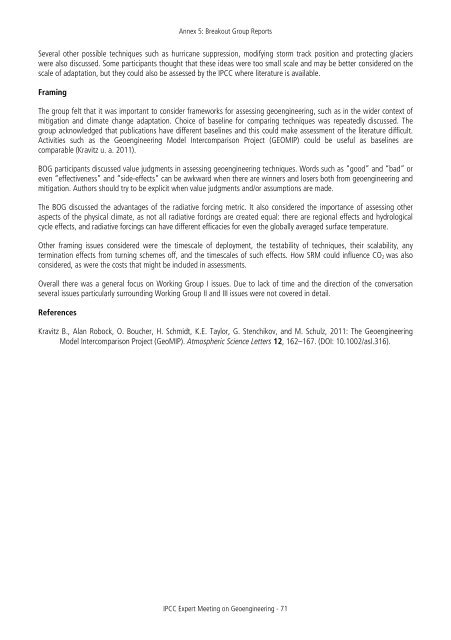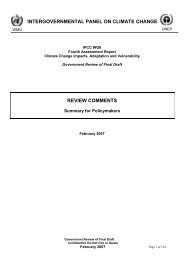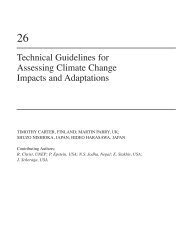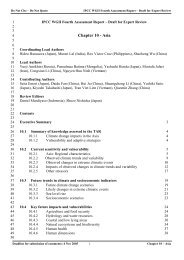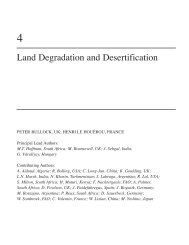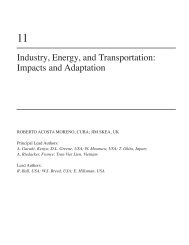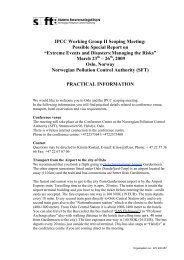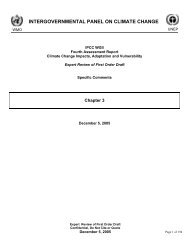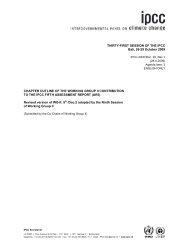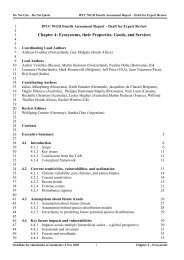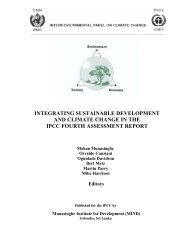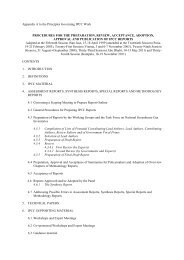IPCC Expert Meeting on Geoengineering
IPCC Expert Meeting on Geoengineering
IPCC Expert Meeting on Geoengineering
Create successful ePaper yourself
Turn your PDF publications into a flip-book with our unique Google optimized e-Paper software.
Annex 5: Breakout Group Reports<br />
Several other possible techniques such as hurricane suppressi<strong>on</strong>, modifying storm track positi<strong>on</strong> and protecting glaciers<br />
were also discussed. Some participants thought that these ideas were too small scale and may be better c<strong>on</strong>sidered <strong>on</strong> the<br />
scale of adaptati<strong>on</strong>, but they could also be assessed by the <str<strong>on</strong>g>IPCC</str<strong>on</strong>g> where literature is available.<br />
Framing<br />
The group felt that it was important to c<strong>on</strong>sider frameworks for assessing geoengineering, such as in the wider c<strong>on</strong>text of<br />
mitigati<strong>on</strong> and climate change adaptati<strong>on</strong>. Choice of baseline for comparing techniques was repeatedly discussed. The<br />
group acknowledged that publicati<strong>on</strong>s have different baselines and this could make assessment of the literature difficult.<br />
Activities such as the <strong>Geoengineering</strong> Model Intercomparis<strong>on</strong> Project (GEOMIP) could be useful as baselines are<br />
comparable (Kravitz u. a. 2011).<br />
BOG participants discussed value judgments in assessing geoengineering techniques. Words such as “good” and “bad” or<br />
even “effectiveness” and “side-effects” can be awkward when there are winners and losers both from geoengineering and<br />
mitigati<strong>on</strong>. Authors should try to be explicit when value judgments and/or assumpti<strong>on</strong>s are made.<br />
The BOG discussed the advantages of the radiative forcing metric. It also c<strong>on</strong>sidered the importance of assessing other<br />
aspects of the physical climate, as not all radiative forcings are created equal: there are regi<strong>on</strong>al effects and hydrological<br />
cycle effects, and radiative forcings can have different efficacies for even the globally averaged surface temperature.<br />
Other framing issues c<strong>on</strong>sidered were the timescale of deployment, the testability of techniques, their scalability, any<br />
terminati<strong>on</strong> effects from turning schemes off, and the timescales of such effects. How SRM could influence CO 2 was also<br />
c<strong>on</strong>sidered, as were the costs that might be included in assessments.<br />
Overall there was a general focus <strong>on</strong> Working Group I issues. Due to lack of time and the directi<strong>on</strong> of the c<strong>on</strong>versati<strong>on</strong><br />
several issues particularly surrounding Working Group II and III issues were not covered in detail.<br />
References<br />
Kravitz B., Alan Robock, O. Boucher, H. Schmidt, K.E. Taylor, G. Stenchikov, and M. Schulz, 2011: The <strong>Geoengineering</strong><br />
Model Intercomparis<strong>on</strong> Project (GeoMIP). Atmospheric Science Letters 12, 162–167. (DOI: 10.1002/asl.316).<br />
<str<strong>on</strong>g>IPCC</str<strong>on</strong>g> <str<strong>on</strong>g>Expert</str<strong>on</strong>g> <str<strong>on</strong>g>Meeting</str<strong>on</strong>g> <strong>on</strong> <strong>Geoengineering</strong> - 71


